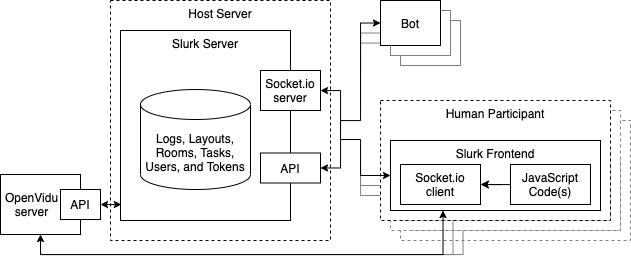Slurk (think "slack for mechanical turk"...) is a lightweight and easily extensible chat server built especially for conducting multimodal dialogue experiments or data collections. See Slurk: What’s this? for a description of the key concepts. Or jump right in with the Getting Started Guide!
The main idea of Slurk is to have a platform that can be used with no change to the Slurk Server by creating task-specific bots. The bots can create rooms, custom chat layouts, and control the distribution of users to rooms. In the following architecture overview, the key components of Slurk are outlined.
Slurk is built in Python 3.9, on top of Flask and Flask-SocketIO. The latest version lives on the master branch. Branch 2.0.0 holds an older version.
To run slurk, the simplest way is to use docker
$ docker run -p 5000:80 slurk/server
[2021-07-24 10:49:41 +0000] [1] [INFO] Starting gunicorn 20.1.0
[2021-07-24 10:49:41 +0000] [1] [INFO] Listening at: http://0.0.0.0:80 (1)
[2021-07-24 10:49:41 +0000] [1] [INFO] Using worker: geventwebsocket.gunicorn.workers.GeventWebSocketWorker
[2021-07-24 10:49:41 +0000] [8] [INFO] Booting worker with pid: 8
[2021-07-24 10:49:42,779] WARNING in database: SQLite should not be used in production
admin token:
01234567-89ab-cdef-0123-456789abcdef
Now you may create a room and a token with the provided admin token, open http://localhost:5000 in your browser, and log in. The full documentation on GitHub contains a detailed step-by-step guide on how to proceed further.
Happy slurking!

